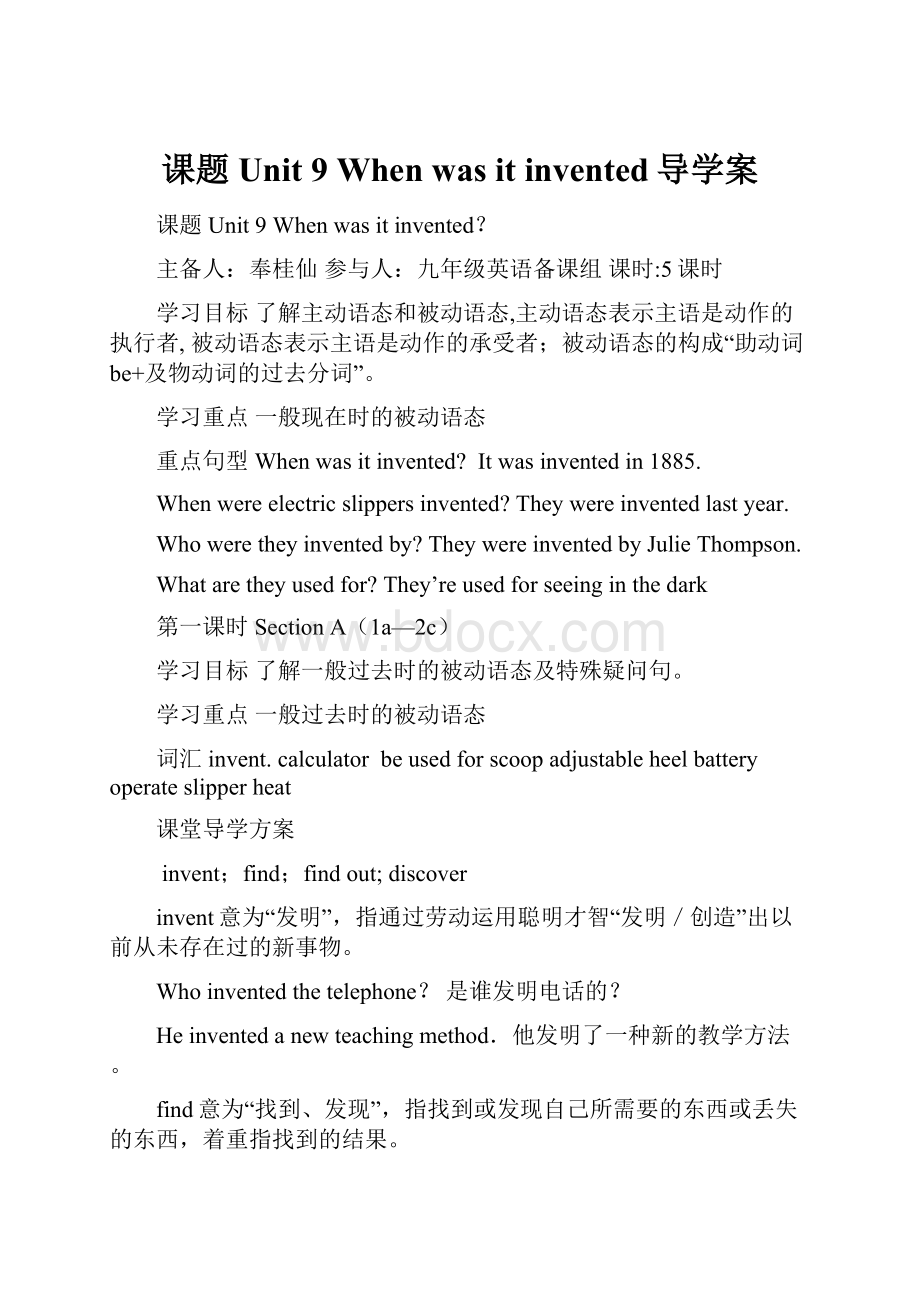课题 Unit 9 When was it invented导学案Word格式.docx
《课题 Unit 9 When was it invented导学案Word格式.docx》由会员分享,可在线阅读,更多相关《课题 Unit 9 When was it invented导学案Word格式.docx(13页珍藏版)》请在冰豆网上搜索。

invent意为“发明”,指通过劳动运用聪明才智“发明/创造”出以前从未存在过的新事物。
Whoinventedthetelephone?
是谁发明电话的?
Heinventedanewteachingmethod.他发明了一种新的教学方法。
find意为“找到、发现”,指找到或发现自己所需要的东西或丢失的东西,着重指找到的结果。
We'
vefoundoilundertheSouthSea.我们已在南海发现了石油。
Theyfinallyfoundaway.他们终于找到了办法。
意为“发现”,表示“偶然”或“经过努力”发现客观存在的事物、真理或错误,即指发现原来客观存在但不为人所知的事物,也可表示发现已为人所知的事物的新的性质或用途。
ColumbusdiscoveredAmericain1492.哥伦布1492年发现了美洲。
Wesoondiscoveredthetruth.我们很快就弄清了真相。
findout指经过研究或询问查明某事或真相。
I'
vefoundyououtatlast.我终于把你揭露了。
PleasefindoutwhentheshipsailsforNewYork.请打听一下那艘船什么时候开往纽约。
Pleasefindoutwhattimethedelegationwillcome.请查一查代表团什么时候来。
1.Edison____theelectriclamp.
2.Ilostmynecklacelastnight.Ihaven’t____it.
3.Who____Americafirst?
4.Canyou____whattimethetrainleaves?
beusedby的意思是“由(被…使用。
”“usedto加不定式”表示过去常常干某事现在不在干了。
例如:
Iusedtogotoworkbybus.NowItakeataxi.Sheusedtobeveryshy.
“beusedtodoing”表示习惯于干某事
▲beusedfor意为“(某物)被用做……”其后接名词、代词或动名词。
如:
(1)Thiskindofbamboocanbeusedforwaterpipes.这种竹子可用作水管。
(2)Aknifecanbeusedforcuttingbread.刀可用来切面包。
beusedtodosth.也可表示“(某物)被用做……”,但其后接动词原形。
(3)Ahammerisusedtodrivenails.锤子是用来敲钉子的。
提示:
beusedas相当于beusedfor的用法。
(4)Thegirlisbeingusedasaservantinthehouse.这个女孩在家里被当做佣人使唤着。
达标检测单项选择
()1ThePeople'
sRepublicofChina__onOctober1,1949.
A.foundB.wasfoundedC.isfoundedD.wasfound
()2English____inCanada.A.speaksB.arespokenC.isspeakingD.isspoken
()3ThisEnglishsong__bythegirlsafterclass.
A.oftensingsB.oftensangC.isoftensangD.isoftensung
()4Thiskindofcar___inJapan.A,makesB.madeC.ismakingD.ismade
()5Newcomputers___allovertheworld.A.isusedB.areusingC.areusedD.haveused
用所给词的适当形式填空
1.Edisonwasagreat____(invent)andheinventedmorethanonethanonethousand____(invent).
2.Theoldpeopleshould_____(speak)topolitely.3.Astampisusedfor______(send)letters.
4.–Who_____(save)herfather?
---He(save)bythatpoliceman.
5.Theteacher’soffice_______(clean)byusyesterday.
第二课时(3a-4)
学习目标熟练掌握被动语态用法,学会用被动语态表达对发明事物的认识和看法。
学习重点1.熟练运用一般过去时的被动语态。
2词汇Lightbulbmicrowaveoven
教学流程1.课前热身。
2.合作探究。
3.检测
1.hear和listen
to
hear只是强调听见了,指声音传进了耳朵。
listen
to的意思是集中注意力,尽量听清楚。
例如:
Suddenly
I
heard
a
strange
noise.我突然听到一个奇怪的声响。
can
hear
you.我能听到你说话。
Listen
me
please.请听我说。
them
talking
in
next
room,but
didn‘t
really
listen
what
they
were
saying.
我听到他们在隔壁房间里说话,但我实在没注意听他们说什么。
当谈到听音乐、无线电广播、演讲、讲课等时,要用hear。
Did
you
Jack‘s
talk
on
Tuesday?
你听了星期二杰克的演讲吗?
但是可以说:
spent
the
night
listening
records.
我听了一晚上的唱片。
(不是公开演出)
注意:
hear一词一般不用于进行时。
不说I
am
hearing或I
was
hearing,
而用can或could。
somebody
coming.我能听见有人来了。
2.被动语态语态是动词的一种形式,它表示主语和谓语的关系。
语态有两种:
主动语态和被动语态。
如果主语是动作的执行者,或者是说动作是由主语完成的,要用主动语态;
如果主语是动作的承受者,或者是说动作不是由主语而是由其他人完成的,则用被动语态。
拓展:
被动语态各时态构成表
TENSE主动语态被动语态
一般现在时be+V.\V.sam\is\are+V(p.p)
一般将来时will\begoingto+V.willbe+V(p.p)
现在进行时am\is\are+V.ingam\is\are+being+V(p.p)
一般过去时①was\were②V.edwas\were+V(p.p)
现在完成时have\has+V.p.phave\has+been+V(p.p)
过去完成时had+V.p.phad+been+V(p.p)
过去进行时was\were+V.ingwas\were+being+V(p.p)
情态动词情态动词+V.情态动词+be+V(p.p)
3.感官动词或使役动词使用省略to的动词不定式,主动语态中不带to,但变为被动语态时,须加上to。
例:
makesomebodydosomething→somebody+be+madetodosomething
seesomebodydosomething→somebody+be+seentodosomething
1.Agirlsawmywalletdropwhenshepassedby.→Mywalletwasseentodropbyagirlwhenshepassedby.
2.Thebossmadethelittleboydoheavywork.→Thelittleboywasmadetodoheavyworkbytheboss.
达标检测
1.PeoplespeakEnglishinmanycountries.English__________________inmanycountries.
2.Webuiltthisbridgelastyear.Thisbridge___________________________lastyear.
3.Thetigerinthezoofrightenedthelittlegirl.
Thegirl_______________bythetigerinthezoo.
4.XiaoLiuhasinvitedyoutoalunchparty.
You___________________________________________toalunchparty.
5.Youmustnottakethesemagazinesoutofthereading-room.
Thesemagazines________________________________thereading-room.
6.Weshalldiscusstheproblemattomorrow'
smeeting.
Theproblem_____________________byusattomorrow.
1.MPSisusedfor(play)music.2.Hehastwo(radio).
3.Acomputerisoneof(use)inventionsintheworld.
4.Howmanymagazinescan(borrow)formthelibraryeveryweek?
5.Hehas(invent)manythingsinhislife.
第三课时(1a-2c)
学习目标学会表达这些创造和发明对你的生活的帮助或对生活质量的提高和认识。
学习重点1.有关薯条的相关知识。
2.词汇crispysaltysourbymistakechefsprinkle
教学流程1.课前预习。
2.听力检测。
3.小组展示
课堂导学方案
salty是形容词。
意为“咸的,含盐的”。
Itissalty.这是咸的Idon'
tlikesaltyfood.我不喜欢咸的食物
Mistake1动词弄错,误解
Youmistookmymeaningentirely.你完全误会了我的意思。
Imistookthenumberandwenttothewrongroom.我记错号码,走错了房间
2.名词错误,过失;
误会
Tomdidn'
tmakeasinglespellingmistakeinhiscomposition.
汤姆在这篇作文里一个字也没拼错。
Bymistake错误地Heputsaltintohisteabymistake.他把盐误放进茶里
达标检测一.选择填空
1.AKnifeisusedfor________thingsAcuttingB.cutCcutsDtocut
2.Annais______tochooseherownclothes.A.allowedB.allowsC.allowingD.allow
3.Hefinishedthehomework_________.A.intheendB.otheendC.bytheendD.attheend
4.Pens______writing.A.usedtoB.areusedasC.areusedbyD.areusedfor
5.__________isusedforseeinginthedark.
A.TheshoeswithadjustableheelsB.Thebattery–operatedslippers
C.TheheatedicecreamscoopD.Theflyingdisk
6.Ican’twakeupinthemorning.WhatshallIdo?
Buy_______,itmayhelp.
A.alightbulbB.amicrowaveovenCanalarmclockD.abinoculars
7.Yourcitylooksbeautiful!
Yes.Lotsoftreesandgrass___lastyear.
A.areplantedB.haveplantedC.wereplantingD.wereplanted
8.WhereisMary?
She_____inthecinemaanhourago.A.sawB,seesC.isseenD.wasseen
9.Look!
Aboyisfalling_____theriver.Let’sgoandsavehim.A.intoB.offC.overD.down
10.Itookthewrongtrain_____,Ididn’tevenknowituntilhalfanhourlater.
A.bymistakesB.bymistakeC.withmistakeD.withmistakes
根据句意及首字母提示完成下列句子.
1.Mumaddedsalttothesoup,butitwasn’ts_____enough.
2.Myfatherworksasac_____inarestaurant.3.Thisorangeistoos_____.
4.Thebiscuitsareveryc_____.Ilikethem.5.I’mheavierthanJimmeansJimist___thanme.
第四课时(3a-4)
学习目标全面掌握被动语态。
学习重点1.短文3a2.词汇ancientfallintoremainnoticeproducepleasantinthiswaypiethrowtaste
教学流程1.自己阅读短文2.回答短文中的问题3.写作
Accident1.事故;
灾祸Hediedinanautomobileaccidentyearsago.他数年前死于车祸
2意外事情;
偶然因素,机遇Thediscoverywasahappyaccident.这一发现出人意料,令人高兴
Byaccident意外事情;
偶然因素,机遇
Thediscoverywasahappyaccident.这一发现出人意料,令人高兴。
Taste的用法作名词,意为“味道,滋味”作系动词,意为“尝起来”,后跟形容词作表语。
作实义动词,意为“尝,品尝”,作形容词,意为“味道好的”。
达标检测用单词的适当形式完成句子。
1.Theyareusedfor_________(change)thestyleoftheshoes.
2Laterhedecided_________(taste)thehotmixture.
3.This_________(specially)penwasinventedbyZhengJie.
4.The_________(fly)diskwasinventedbycollegestudents.
5.Someleavesfromanearbybushfellintothewaterand_________(remain)forsometime.
词形变换专项练习题
1.AmymakesfewermistakesthanPeter.Shedoesherhomework___(careful).
2.Johnis__________(luck)enoughtomissthefirsttrain.
3.Theguidesaidthatmuchattentionmust___________(pay)tothesedetails.
4.Myfriendtoldmethathewasn’tusedto__________(travel)byplaneandheusedto_________(feel)sickalot.
5.Thankyoufor_________metotheparty,I’mgratefultoyouforyour_______(invite).
6.Bythetimehewas12,he_____________(teach)himselfFrench.
7.Hewatchedtheresultofthetestandthen___________(draw)aconclusion.(得出结论)
8.Sofar,we___________(hold)twelvesportsmeetings.
9.Thiscameradoesn’tbelongto_________(he),it’s_________(I).
10.Thiscarcoststoomuch.Don’tyouhavesomething_________(cheap)?
阅读理解:
WhenyouarelearningEnglish,youfinditnotclevertotranslateanEnglishsentence,wordforword,intoyourownlanguage.Takethesentence“Howdoyoudo?
”forexample.Ifyoulookupeachwordinthedictionary,oneatatime,whatisyourtranslation?
Itmustbeawrongsentenceinyourownlanguage.
Languagesdon’tjusthavedifferentsounds,theyaredifferentinmanyways.It’simportanttomastertherulesforwordorderinthestudyofEnglish,too.Ifthespeakersputwordsinawrongorder,thelistenercan’tunderstandthespeaker’ssentenceeasily.SometimeswhentheorderofwordsinanEnglishsentenceischanged,themeaningofthesentencechanges.Butsometimestheorderischanged,themeaningofthesentencedoesn’tchangebetweenthetwopairsofsentences:
“Sheonlylikesapples.”“Onlyshelikesapples.”
“Ihaveseenthefilmalready.”“Ihavealreadyseenthefilm.”
WhenyouarelearningEnglish,youmustdoyourbesttogetthespiritofthelanguageanduseitastheEnglishspeakerdoes.
()1.FromthepassageweknowthatwhenwearelearningEnglish.
A.weshouldn’tputeverywordintoourlanguage
B.weshouldlookup